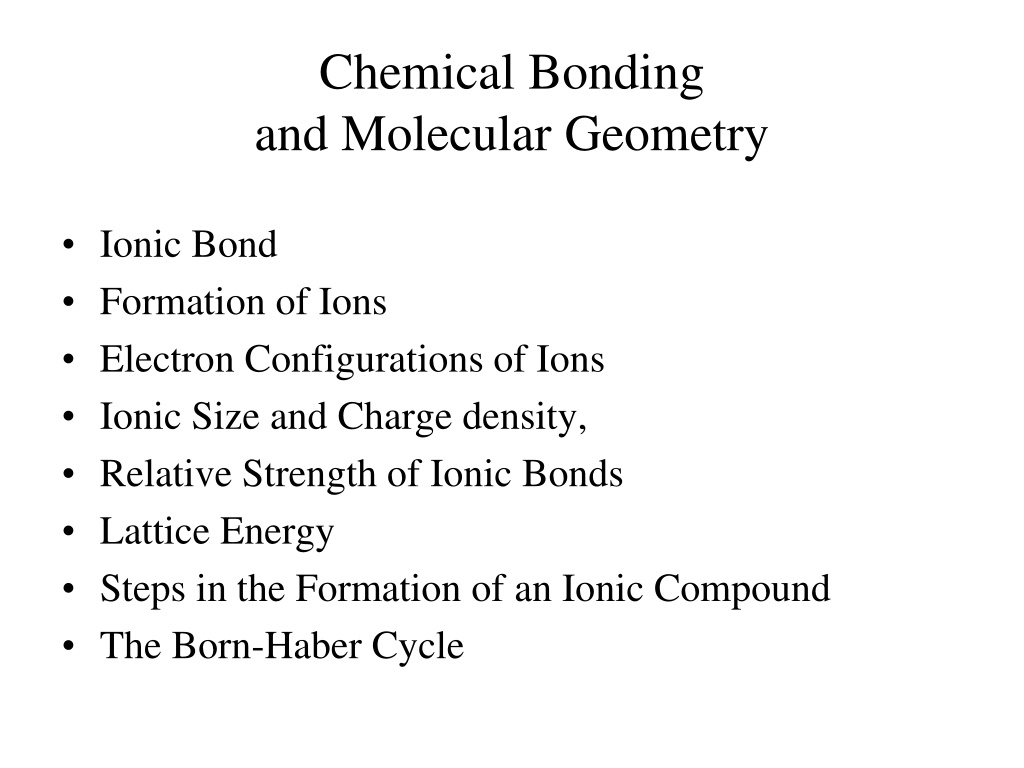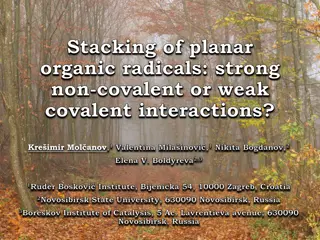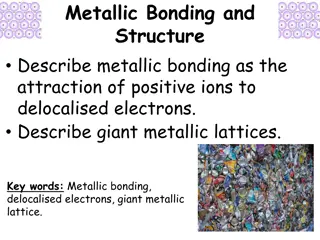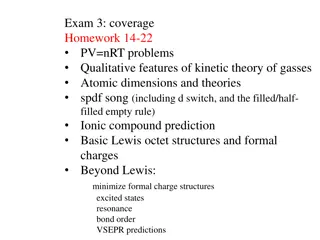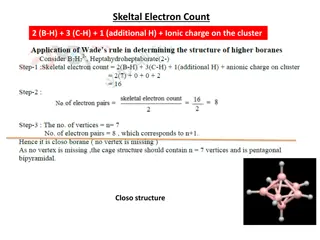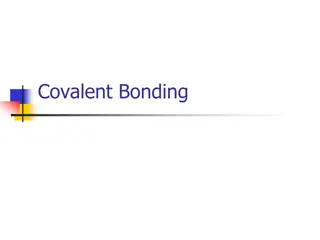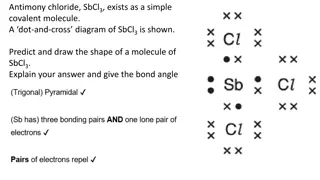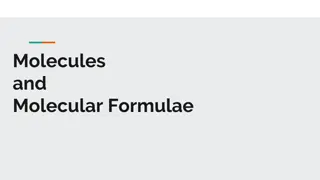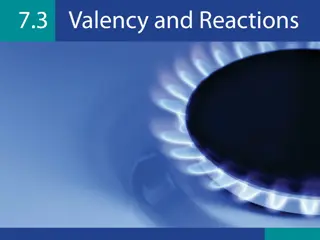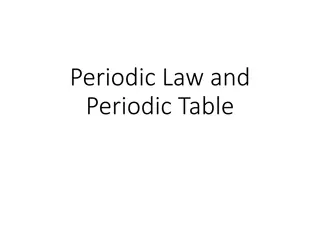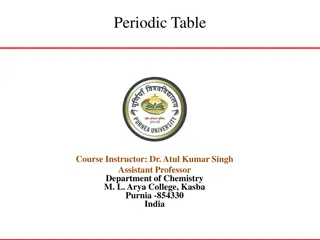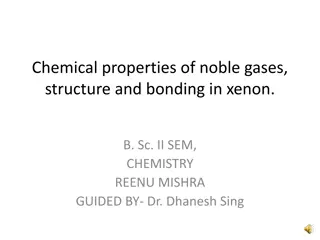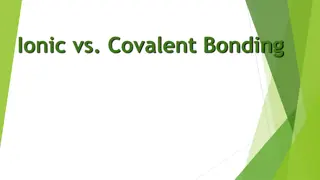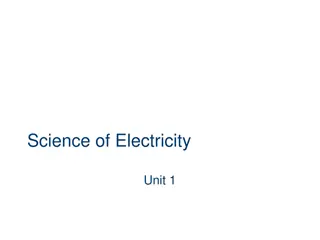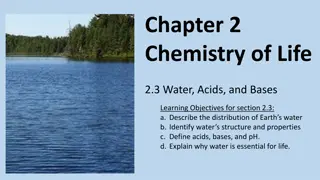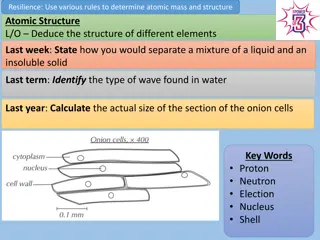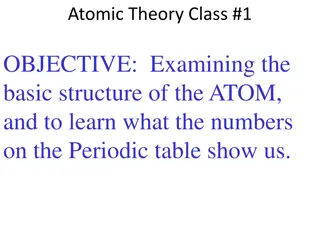Understanding Chemical Bonding and Atomic Properties
Explore the formation of ionic and covalent bonds, electron configurations of ions, and molecular geometry. Learn about ionic compound formation, atomic properties like effective nuclear charge, atomic size, ionization energy, and electron affinity. Discover the essential concepts of cations formation and the interactions in ionic compounds.
Uploaded on Sep 24, 2024 | 0 Views
Download Presentation

Please find below an Image/Link to download the presentation.
The content on the website is provided AS IS for your information and personal use only. It may not be sold, licensed, or shared on other websites without obtaining consent from the author. Download presentation by click this link. If you encounter any issues during the download, it is possible that the publisher has removed the file from their server.
E N D
Presentation Transcript
Chemical Bonding and Molecular Geometry Ionic Bond Formation of Ions Electron Configurations of Ions Ionic Size and Charge density, Relative Strength of Ionic Bonds Lattice Energy Steps in the Formation of an Ionic Compound The Born-Haber Cycle
Chemical Bonding and Molecular Geometry Covalent Bonds Electronegativity Polarity of Covalent Bonds Lewis Structures and the Octet Rule Exceptions to the Octet Rule Resonance Lewis Structures Bond Energies Calculating Enthalpy using Bond Energy Molecular Shape - The VSEPR Model
Review of Atomic Properties Effective nuclear charge & Atomic Size: 1. Effective nuclear charge increases left-to-right across periods, and decreases top-to-bottom down a group; 2. Atomic size decreases left-to-right across periods, and increases top-to-bottom down a group: 3. Ionization energy incresses left-to-right across a period, and decreases top-to-bottom down a group.
Review on Atomic Properties Atomic Size, Ionization Energy, and Electron Affinity: 1. L-to-R: atomic size decreases; ionization energy increases; electron affinity increases; 2. Top-to-bottom: atomic size increases; ionization energy decreases; electron affinity decreases;
Ionic Compound The atoms in sodium chloride (common table salt) are arranged to (a) maximize opposite charges interacting. The smaller spheres represent sodium ions, the larger ones represent chloride ions. In the expanded view (b), the geometry can be seen more clearly. Note that each ion is bonded to all of the surrounding ions six in this case.
Ionic bonds Attractions between cations and anions; Bonds formed between metals and nonmetals
Formation of Cations Ions are formed when metals react with nonmetals the metal atom loses one or more of its valence electrons to the nonmetal atom; Atoms of representative metals lose valence electrons to acquire the noble gas electron configurations; Cations of representative metals have noble gas electron configurations;
Formation of Cations All Alkali metals (1A): M M++ e- All Alkaline Earth metals (2A): M M2 ++ 2e- Certain Group 3A metals: M M3++ 3e-;
Formation of Anions Nonmetal atoms gain electrons to acquire the noble gas electron configurations; Simple anions have noble gas electron configurations;
Formation of Anions The halogen family (VIIA): X + e- X- The oxygen family (VIA): X + 2e- X2- N and P (in Group VA): X + 3e- X3-
Common Ions of the Representative Elements Ions that are isoelectronic to He (1s2): Li+& H- Ions isoelectronic to Ne (1s2 2s22p6): Na+, Mg2+, Al3+, F-, O2-, and N3- Ions isoelectronic to Ar (1s2 2s22p63s23p6): K+, Ca2+, Sc3+, Cl-, S2-, and P3-
Common Ions of the Representative Elements Ions isoelectronic to Kr (1s22s22p63s23p64s23d104p6): Rb+, Sr2+, Y3+, Br-, and Se2-; Ions isoelectronic to Xe (1s22s22p63s23p64s23d104p65s24d105p6) Cs+, Ba2+, La3+, I-, and Te2-;
Ionic Radii Relative size of isoelectronic ions: Al3+< Mg2+< Na+< Ne < F-< O2-< N3-; Sc3+< Ca2+< K+< Ar < Cl-< S2-< P3-; Trend of ionic radii within a group: Li+< Na+< K+< Rb+< Cs+; F-< Cl-< Br-< I-;
Cations From Transition Metals Atoms of the transition metals lose variable number of electrons; Cations have variable charges; Cations derived from transition metal group do not acquire the noble gas electron configuration;
Electron Configurations of Selected Cations from Transition Metals Examples: Cr: [Ar] 4s13d5 Cr Cr2++ 2e-; Cr2+: [Ar] 3d4 Cr Cr3++ 3e-; Cr3+: [Ar] 3d3 Fe: [Ar] 4s23d6 Fe Fe2++ 2e-; Fe Fe3++ 3e-; Fe2+: [Ar] 3d6 Fe3+: [Ar] 3d5
Charge Density and the Strength of Ionic Bond Charge density = ????????? ?? ? ???? ?? ??? ????? ???? Greater charge magnitude and small ionic radius High charge density stronger ionic bond; Stronger ionic bond High lattice energy; Stronger ionic bond High melting point;
Lattice Energy (UL) Lattice energy - energy released when gaseous ions combine to form solid ionic compound: M+(g) + X-(g) MX(s); UL= Lattice energy Examples: Na+(g) + Cl-(g) NaCl(s); UL= -787 kJ/mol Li+(g) + F-(g) LiF(s); UL= -1047 kJ/mol
Lattice energy Lattice energy k(q1q2/r2) q1and q2= charge magnitude on ions; r = distance between nuclei, and k = proportionality constant. Lattice energy increases as charge magnitude increases and ionic size decreases.
Lattice Energies of Some Ionic Compounds Lattice Energy, UL(kJ/mol) The energy required to separate a mole of ionic solids into gaseous ions; MX(s) M+(g) + X-(g) Mn+/Xn- Li+ Na+ K+ Mg2+ Ca2+ O2- 2942 2608 2311 3919 3570 F- Cl- 853 787 715 2526 2247 Br- 807 747 682 2440 2089 I- 757 704 649 2327 2059 1047 923 821 2957 2628
The Born-Haber Cycle for the Formation of NaCl Na+(g) + Cl(g) _______________ -349 kJ _______ Na+(g) + Cl-(g) +496 kJ Na(g) + Cl(g)___________ Na(g) + Cl2(g)________ ? kJ Na(s) + Cl2(g)________ NaCl(s)_________________ +121 kJ +108 kJ -411 kJ
Chemical Steps in the Formation of NaCl Na(s) Na(g); Cl2(g) Cl(g); Na(g) Na+(g) + e-; Cl(g) + e- Cl-(g); Hs= +108 kJ BE = +121 kJ IE = +496 kJ EA = -349 kJ UL= ? kJ Hf= -411 kJ Na+(g) + Cl-(g) NaCl(s); Na(s) + Cl2(g) NaCl(s); Hf = Hs+ BE + IE + EA + UL ( Hs= Enthalpy of sublimation; IE = Ionization energy; BE = Bond energy; EA = Electtron affinity; UL= Lattice energy; Hf= Enthalpy of formation)
The Born-Haber Cycle for LiF Li+(g) + F(g) _______________ -328 kJ +520 kJ _______Li+(g) + F-(g) Li(g) + F(g)___________ Li(g) + F2(g)________ ? kJ Li(s) + F2(g)________ LiF(s)_________________ +77 kJ +161 kJ -617 kJ
Chemical Steps in the Formation of LiF Li(s) Li(g); F2(g) F(g); Li(g) Li+(g) + e-; F(g) + e- F-(g); Hs= +161 kJ BE = +77 kJ IE = +520 kJ EA = -328 kJ UL= ? Hf= -617 kJ Li+(g) + F-(g) LiF(s); Li(s) + F2(g) LiF(s); Hf = Hs+ BE + IE + EA + UL ( Hs= Enthalpy of sublimation; IE = Ionization energy; BE = Bond energy; EA = Electtron affinity; UL= Lattice energy; Hf= Enthalpy of formation)
The Born-Haber Cycle for MgO Mg2+(g) + O2-(g) _____________ Mg2+(g) + O(g)________ +737 kJ Mg(g) + O(g)_________ Mg(g) + O2(g)________ ? kJ Mg(s) + O2(g)________ MgO(s)_________________ +2180 kJ +247 kJ +150 kJ -602 kJ
Chemical Steps in the Formation of MgO Mg(s) Mg(g); O2(g) O(g); Mg(g) Mg2+(g) + 2e-; O(g) + 2e- O2-(g); Hs= +150 kJ BE = +247 kJ IE = +2180 kJ EA = +737 kJ UL= ? kJ Hf= -602 kJ Mg2+(g) + O2-(g) MgO(s); Mg(s) + O2(g) MgO(s); Hf= Hs+ BE + IE + EA + UL ( Hs= Enthalpy of sublimation; IE = Ionization energy; BE = Bond energy; EA = Electron affinity; UL= Lattice energy; Hf= Enthalpy of formation)
Covalent Bonds Bonds between two nonmetal atoms, or between an atom of semimetal and an atom of nonmetal; Bonds are formed by sharing one or more electron pairs; One, two or three pairs of electrons may be shared between two atoms to form a single, double, or triple covalent bonds, respectively.
Potential Energy Change during the Formation of H2Molecule
Potential Energy for the Formation of H2 The potential energy of two separate hydrogen atoms (right) decreases as they approach each other, and the single electrons on each atom are shared to form a covalent bond. The bond length is the internuclear distance at which the lowest potential energy is achieved.
Polarity of Covalent Bonds 1. Covalent bonds can be polar or nonpolar; Nonpolar covalent bonds - bonds between identical atoms or atoms having the same electronegativity. 2. Polar covalent bonds - bonds between atoms with different electronegativity; 3.
Polar Covalent Bonds 1. Bonds have partial ionic character Bond polarity depends on EN; EN = difference in electronegativity of bonded atoms 2.
Electronegativity Electronegativity = relative ability of bonded atom to pull shared electrons. Trends of Electronegativity: increases left-to-right across periods; decreases top-to-bottom down the group.
Electronegativity Most electronegative element is at top right corner of the Periodic Table (noble gas is excluded): Fluorine is most electronegative with EN = 4.0 Least electronegative element is at bottom left corner of the Periodic Table: Francium is least electronegative with EN = 0.7
General trends: Electronegativity increases from left to right across a period For the representative elements (s and p block) the electronegativity decreasesas one goes down a group Electronegativity trend for transition metals is less predictable.
Electronegativity and Bond Polarity Compound Electronegativity Difference F2 HF LiF 4.0 - 4.0 = 0 4.0 - 2.1 = 1.9 4.0 - 1.0 = 3.0 Nonpolar covalent Ionic (non- covalent) Type of Bond Polar covalent In F2 molecule, electrons are shared equally and the bond is nonpolar; In HF molecule, F-atom is more electronegative than H- atom; electrons are drawn closer to the fluorine atom. H F bond is very polar;
Electronegativity and bond polarity The H-F bond can thus be represented as: The ' +' and ' -' symbols indicate partial positive and negative charges. The arrow indicates the "pull" of electrons off the hydrogen and towards the more electronegative atom. In lithium fluoride the much greater relative electronegativity of the fluorine atom completely strips the electron from the lithium and the result is an ionic bond (no sharing of the electron)
Predicting Bond Type From EN General rule of thumb for bond polarity EN = 0-0.4, bond is non-polar covalent; EN > 0.4, but < 1.9, bond is polar covalent EN > 1.9, bond is considered ionic.
Lewis Symbols and Lewis Structures Lewis symbols illustrating the number of valence electrons for each element in the third period of the periodic table.
Lewis Structure for Cl2 Individual Cl atom (left) has incomplete octet; in Cl2 molecule, each atom acquires the octet state.
Using dash to represent bonding pair and dot-pairs for lone-pairs H2 molecule does not have lone-pair or nonbonding pair; Cl2 molecule has one bonding pair represented by a dash and 3 lone-pairs on each atom.
Drawing Lewis Structures for Molecules or Polyatomic Ions Step-1: Calculate the total number of valence electrons; For polyatomic ions, add one additional electron for each negative charge, or subtract one for each positive charge on the ion.
Lewis Structures for Molecules and Polyatomic ions Step-2: Choose a central atom; normally the least electronegative atom in the group; (Hydrogen and Fluorine cannot become central atoms) Connect other atoms to the central atom with single bonds (a pair of electrons).
Lewis Structures for Molecules and Polyatomic ions Step-3: Complete the octet state of all terminal atoms, except hydrogen, using available valence electron pairs; Place remaining pairs of electrons (if present) on central atom as lone pairs.
Octet State of Central Atom Step-4: If the central atom has not achieved the octet state, but all valence electrons have been used, move one or more lone-pair electrons from terminal atoms, one pair at a time, to form a double or triple bonds to complete octet of the central atom.
Lewis Model for the Formation of Covalent Bonds and Covalent Molecules
Lewis Structures of Formaldehyde and Ethylene A double-bond can be represented by a double lines or two pairs of dots.
Triple Bonds A triple bonds can be represented by a triple lines or three pairs of dots.
